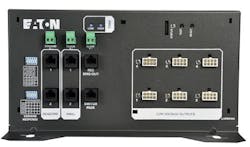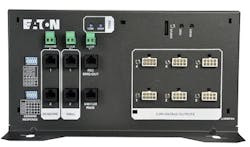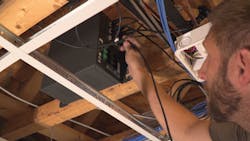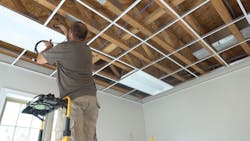The first commercial installation of a new distributed low-voltage power platform for SSL delivers unprecedented ease of installation and excellent integration of controls, reports MAURY WRIGHT, and the scheme should also deliver added efficiency due to centralized power conversion.
Back at LightFair International (LFI) in April, Eaton (formerly Cooper Lighting) displayed a new distributed low-voltage power (DLVP) platform intended to simplify the installation and control of LED-based lighting and to further optimize the efficiency of solid-state lighting (SSL) through centralized AC-to-DC power conversion. Now Eaton has completed its first beta installation of a DLVP system in a small office building in Cincinnati, OH. The full impact of the DLVP platform remains to be determined in terms of energy efficiency. But the early indication is that the DLVP platform delivered superbly both in terms of the promised ease of installation and the inherent network and controls capability of the platform.
Interested in articles & announcements on lighting controls?
We have covered the concept of DC power grids on a recurring basis for several years, including in a feature article that explored the potential benefits of a move to DC power and the myriad options available to make such a transition in SSL systems. Back at the time of that feature article, it appeared that the DC grid promulgated by the EMerge Alliance would offer the most likely path to success in DC power. But times and technologies have surely changed.
Of late, we have most often covered Power-over-Ethernet (PoE) technology as the surging option - in terms of popularity - that provides a way to power and network LED lighting using standard Ethernet cables. The fact that IT networking stalwart Cisco has put considerable marketing and technology dollars behind the PoE push has been a huge driver of the buzz around that technology. And of course PoE is an open, industry-standard platform, although sometimes that's an easy to forget fact with a behemoth such as Cisco involved.
Third option
Now it appears we have a third option from Eaton, and that option might just be the most in tune with the requirements of the SSL sector. It came as a bit of a surprise when Eaton rolled out the DLVP platform at LFI, because the company is a participant in other DC-grid technologies. Indeed, Eaton has been a member of the EMerge Alliance and offered luminaires compatible with that scheme - at least on a limited basis. There has been no high-volume commercialization of the EMerge platform, despite its many technical merits.
Eaton is also a participant in Cisco's Digital Ceiling initiative that is centric to PoE technology. And the company has a number of luminaire products available in PoE flavors. Essentially, all it takes is a change in the modular driver in a luminaire to support a different power-distribution scheme.
Frankly, we may have dismissed the DLVP demonstration at LFI as simply a proprietary offering with limited potential, but Eaton made a sincere pledge that it would open the platform to use by other lighting manufacturers, as we covered in a video interview at LFI with Eaton executive Ken Walma. Moreover, the platform seemed extremely well architected from a technology perspective.
DLVP platform
The heart of the DLVP platform is a power distribution module (PDM) that is roughly equivalent to the power supply in an EMerge Alliance system. The PDM unit (Fig. 1) includes multiple DC-voltage output channels that meet UL and NEC (National Electrical Code) Class 2 requirements for low-voltage wiring. The Class 2 designation means that the power cables can be free run like Ethernet cables and not through conduit to electrical junction boxes that are a necessary staple in AC power distribution.
FIG. 1. The power distribution module (PDM) in a DLVP system includes connectors for DC power channels that can each drive multiple luminaires and separate connectors to implement sensors and controls.
Eaton did design a cable technology and connector scheme that the company feels is far more robust and reliable than the Cat-5/6 cable used to supply power in PoE systems. Fig. 2 depicts a sample cable. Still, the DLVP system does depend on Cat-5/6-type wiring to connect sensors and controls.
The controls aspect of the DLVP platform is inherent in the PDM, unlike the case with the EMerge Alliance technology where controls must be layered on any given installation. As a lighting designer/specifier, you could deploy a DLVP luminaire without control capability beyond on and off. But there is inherent support for more such as autonomous dimming based on daylight and occupancy sensors.
Of course, the jury will be out on the DLVP platform for some time. Eaton's Walma, who heads the company's controls business, reported after LFI that several other lighting manufacturers had expressed sincere interest in using the DLVP technology. Meanwhile, Eaton is readying a commercial launch of luminaires, sensors, controls, cables, and more that will most likely happen before you read this article. And as we will discuss in the remainder of this article, the technology is off to an impressive debut.
Alpha and beta
When we interviewed Chris Andrews, product manager for low-voltage lighting and control systems at Eaton, for this article, we were a bit surprised at how long Eaton has been working on the DLVP platform. At LFI, the DLVP demo didn't appear to be something cooked up in an R&D lab in the week before the showing. But generally companies show such technology platforms a year or more before commercial deployment. But Andrews had been on the DLVP project for more than three years along with working on the other DC-grid schemes.
Eaton has had what it considers alpha installations of the DLVP technology in place for some time. These installations are within Eaton facilities. Over the summer, Eaton completed the first beta installation at an actual customer site. Andrews said the company looks for beta opportunities through its normal sales channels that are a good fit for the new technology in question, and that are in organizations amenable to perhaps some hand holding and growing pains as well as working with Eaton to deliver feedback on the project on an ongoing basis. The beta customer presumably gets a discount and access to new technology, just as beta programs have always worked in the broader electronics technology sector.
FIG. 2. Custom cables developed by Eaton are used in a plug-and-play manner to link the PDM to luminaires.
In the Cincinnati project, Eaton worked with USGreentech, a company focused on environmentally-friendly, artificial surfaces for athletic playing fields. The customer's green focus aligned well with the green aspects of both LED technology and the DLVP platform. The installation would simultaneously save energy and minimize the use of building materials.
The project
USGreentech was opening a new corporate office in the Cincinnati area that would total around 2000 ft2. Ultimately, the DLVP platform will serve far larger spaces, but the project that comprised offices, meeting spaces, a lobby, and more was an appropriate proving ground for DVLP. Andrews said the project offered another compelling aspect. It would invariably need some AC-powered lighting, although 75% of the project would be DLVP products. But the mix afforded Eaton the chance to test how well the DLVP system could accommodate a mix of power grids with a unified controls platform based in the PDM.
FIG. 3. Making the connection between the PDM and a luminaire is simple, and the cable is left exposed in the raised ceiling and secured with simple cable ties just like Ethernet cable.
The first test of the technology came in the installation, and that phase delivered what are the most concrete data in terms of DLVP benefits. Quentin Mecklenborg is the owner of a contracting firm called Brooks and Sons in the Cincinnati area that performed the installation on the project. Mecklenborg said a typical commercial office space in the 2000-ft2 range would take a two-man crew a day and a half to two days to install and wire the lighting. He said he did the entire install in about five hours.
Mecklenborg's results were perhaps more impressive than you might first realize. He had never installed any LED lighting before, although he had done legacy lighting installations for years. Moreover, he knew nothing about the DLVP technology prior to the USGreentech project. Mecklenborg said subsequent installs would surely go faster.
Simplified installation
The ease of installation is due to a number of factors. Mecklenborg had considerable experience running low-voltage cables such as standard Ethernet cables. He said the DLVP cables were installed in exactly the same manner. The cables are fastened with cable ties or similar cable-bundling schemes and again require no conduit or junction boxes. Fig. 3 shows a worker connecting a cable to one of the PDM units installed in the plenum space with simple connectors to both luminaires and controls, and the wiring is installed outside conduit just as you can see the blue Ethernet cables in the photo.
The benefits of the DLVP technology in terms of installation also extended to the controls. Mecklenborg said that with legacy lighting technology, most of the controls would be installed in junction boxes with AC wiring and conduit run to each box. The DLVP sensors and controls could be mounted to simple holes in ceilings and walls with no junction box and no conduit. Mecklenborg termed the installation a "plug-and-play system."
Mecklenborg did report some issues with the inspection process. The local inspectors had never seen a low-voltage, office-lighting system. But after reviewing the documentation, the inspectors cleared the technology with the exception of emergency lighting and egress or exit lighting. The inspectors insisted that the project team install AC-based luminaires in such roles, although Mecklenborg remains unclear as to why since either DVLP- or AC-powered luminaires will go dark in the case of an AC-power loss.
The emergency situation will surely change with maturity of the DLVP technology or any other DC-grid technology. The EMerge Alliance has long championed the fact that a DC battery could provide backup power in a DC-grid system. And Eaton will surely deliver DLVP-compatible luminaires with battery-backup capability.
FIG. 4. The low-voltage cable connects directly to the luminaires in a DLVP system and a single DC channel can be daisy chained to multiple luminaires.
DLVP architecture
We did also revisit the Cincinnati DLVP installation with Eaton's Andrews. He said the lighting includes Metalux 2×2-ft troffers, a selection of downlights, and other fixtures including under-cabinet lights. Eaton will launch an even broader array of products including seven Metalux luminaire families, probably by press time for this article. And the luminaire offering will be complemented with sensors, power receptacles that can control lamps or legacy sources, and various control panels.
Andrews said generally a 600W PDM could serve to power a 2000-ft2 office. In the Cincinnati project, however, Eaton supplied two 600W PDMs and a 300W PDM to test the distributed capability of the system and the ability to mix and match low-voltage DC and mains-voltage AC products.
The PDMs include multiple 100W channels. A typical channel can be daisy chained to at least four fixtures to share the current. Each fixture must do a DC-DC power conversion to utilize the power.
We initially assumed that the broad range of fixtures that Eaton would quickly offer for DLVP systems was due to the fact that the company could use the same DC-DC-power converter that was in EMerge-Alliance-compatible and PoE fixtures. But in fact, according to Andrews, Eaton has developed converters in-house for each of the different systems.
All of the aforementioned DC grids rely on Class 2 power, but each are different. The EMerge Alliance systems utilize a 24V power bus and PoE uses a 48V bus. Andrews said Eaton stretched the Class 2 limit to near 60V to minimize current on the distributed system. And designing an optimally-efficient converter for each platform required different architectures, but Eaton believes the 60V system will prove most efficient.
Mixing systems
Most of our discussion about the Cincinnati project with Andrews was during the installation phase of the project. But we had the chance to speak with Mecklenborg the week after the client moved into the space. He was on site and saw the system put through its paces. We asked Mecklenborg about the commissioning process because that is the stumbling block for many SSL installations with networked or adaptive controls. But Mecklenborg reported that the commissioning was relatively straightforward. He said the early documentation was ambiguous in some cases, but Eaton had improved instructions and most contractors should be able to install and commission the system.
Moreover, with USGreentech in the new space for a week, Mecklenborg said the occupancy and daylight sensors were working appropriately to dim or extinguish lights when appropriate. And he said the client was happy with the lighting.
In the end, the installation did use what Andrews had projected would be 75% DLVP-compatible lighting products. The client wanted some decorative pendants in the lobby that required exposed LED lamps and the need for a vintage look. Those LED lamps comprised part of the mains-voltage lighting along with the emergency and egress fixtures mentioned earlier.
But the DLVP concept has been intended from the start to support mains-powered lighting. Eaton has controls that can connect directly to the PDM and then deliver phase-controlled AC power to legacy lights for dimming. Moreover, the systems will ultimately bridge to 0-10V and other analog and digital control schemes, Mecklenborg said the integrated system was working seamlessly in the USGreentech facility. Fig. 4 shows a wide shot of a worker connecting a cable to one of the troffers installed in an open space.
Of course, Eaton is still riding multiple horses in the DC-grid space. Even while the Cincinnati project was in the planning and installation phase, Eaton announced a partnership with NuLEDs focused on PoE systems. It will be interesting to see if other lighting manufacturers sign on to support DLVP and how Eaton navigates the suddenly crowded space.









